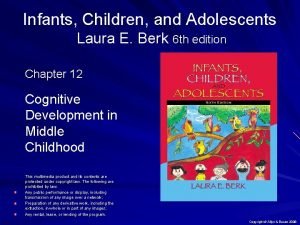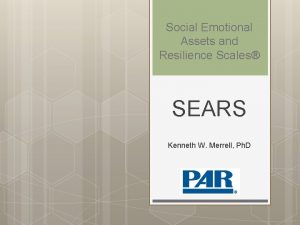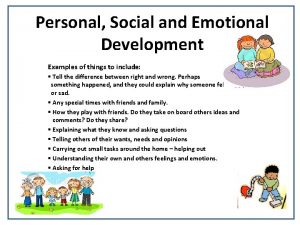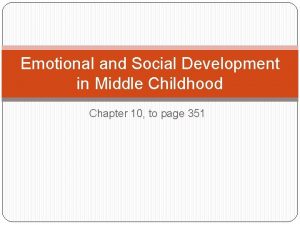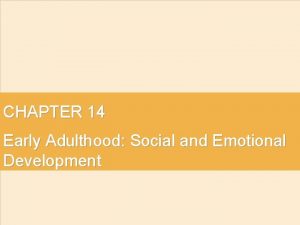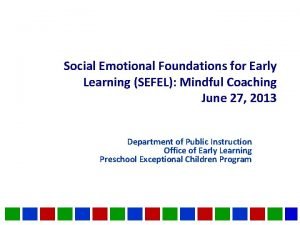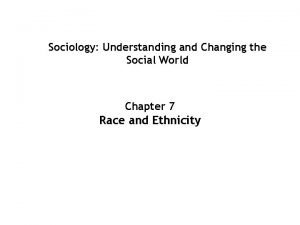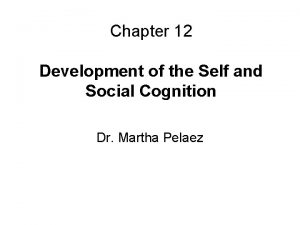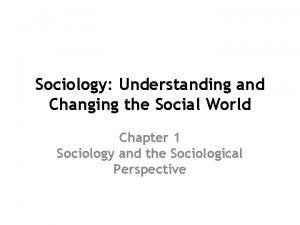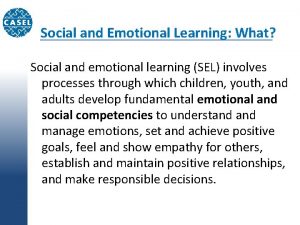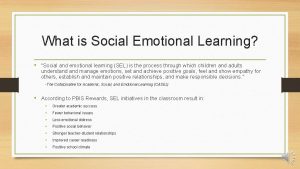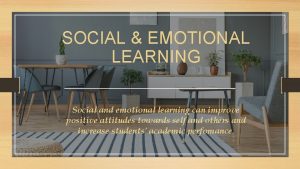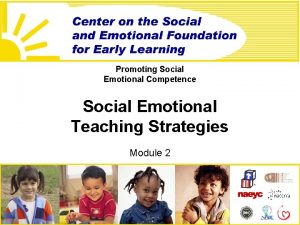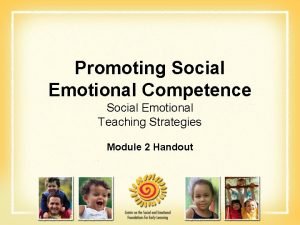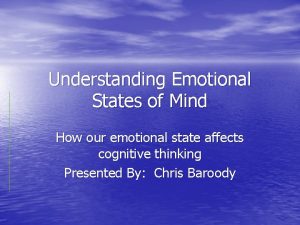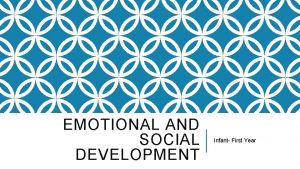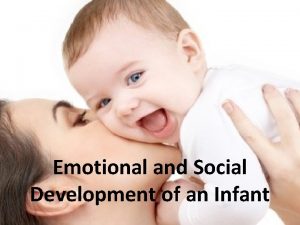Understanding the Social and Emotional Lives of Adolescents















- Slides: 15

Understanding the Social and Emotional Lives of Adolescents Neal L. Mc. Intyre Plymouth State University College of Graduate Studies Kimball Union Academy

Guiding Questions • Who are we trying to help? • What are the emotional/physiological differences between teachers and adolescent students? • How do we identify students in emotional distress? • When do we intervene? • Why should they seek our counsel?

Guiding Thoughts • “Michael Bradley, a Philadelphiaarea psychologist and author specializing in teenagers, says U. S. culture tends to view teens as small adults when, neurologically, they are large children. ” • “Neurological researchers around the country, spearheaded by Jay Giedd of the National Institute of Mental Health, have in recent years found that the brain is not fully developed until after 18. The brain system that regulates logic and reasoning develops before the area that regulates impulse and emotions, the researchers say. ”

Emotional Pressure: Beginning with an Example • A. B. C. D. • Alcohol can be used as an example of adolescents regulating or coping with social/emotional pressures. By using alcohol, students can find: Outlet and escape from pressures Social acceptance, alleviate peer pressures. CONTROL over something! The average when youth first try alcohol is 11 years for boys and 13 years for girls. The average at which Americans begin drinking regularly is 15. 9 years old. Source: National Center on Addiction and Substance Abuse, Columbia University When do we see this? How do we commonly intervene with alcohol use/abuse?

Stages of Adolescent Emotional Development • • • Stage 1: Identity vs. Identity Diffusion Kids undergo a period of experimentation with various aspects of their role, generally finding constructive roles. Identity is being formed, and students can begin answering “Who am I? ”. That said, experimentation with new roles as mentioned above causes kids to behave outside of themselves, and this period is often a rebellious phase of their development.

Stages of Adolescent Emotional Development • Stage 2: Emotional Moratorium • Due to a variety of social and physiological cues, adolescents undergo many subtle stages of emotional upheaval as they experiment with how their changing identity can cope with each arising pressure. A moratorium stage, however, is when a young person undergoes a period of “emotionless” behavior; they become outwardly despondent, incommunicative (especially with adults), and seem withdrawn.

Stages of Adolescent Emotional Development Stage 3: “Play-acting” In American culture, many adolescents are afforded an extended period of insulation from parents. This allows them to take additional risks and “try on” a multitude of roles. All of these stages are not without social/emotional risks, and students can be susceptible to negative pressures which can send normal, healthy development in an unhealthy direction.

Outside of Their Ability • So, what things are commonly (not uniformly) outside of the cognitive, emotional, and social abilities of adolescents? 1. Understanding love and true intimacy 2. Generative empathy 3. Foresight which opposes impulse *these are generalizations, and can be applied differently to boys and girls as well as individuals.

Consider: Kids are being asked to define themselves and their future professional pursuits at younger ages; they need to grow-up faster. All of this is happening in a time of emotional and social uncertainty in their lives. What could that mean about the certainty of their future endeavors?

Questions? Comments?

Fundamental Disconnect • • By nature, teens and the adults in their lives are fundamentally different. For that matter, each teacher comes from a very different background and philosophy toward working with teens. Goals: Adults tend to be focused on goals. Teens are still developing meaningful, longterm goals, but are considerably more focused on short-term means of gratification. Transitions: teens undergo regular periods of transition in their social/emotional lives, while their adult counterparts have fewer disruptions and tend to have more stable and predictable lives. Experience: adults clearly have more life experience, and can handle turmoil more readily. During this period of upheaval even the smallest things seem significant.

• • Adolescents will change over time in noticeable ways, but we should watch for abrupt changes which may signal real distre Withdrawal: can be subjective to the studen but watch for noticeable and lasting periods diminished interaction with adults and peer Anger: periods of verbal and physical aggression signal an emotional upwelling characteristic of many teens, but should be measured in intensity and duration. Mood Swings: watch for extreme swings in emotion, overreactions, extreme sensitivity, and irrational behavior. Is the behavior increasing in intensity? Is the behavior sustained in all interactions? Are there any evident secondary symptoms? Sleepiness/insomnia, loss of appetite, use of tobacco or drugs suspecte How do students tell us they’re in trouble?

Questions? Comments?

When do we intervene? How can we • RULE #1: YOU DO NOT NEED SOLVE THE PROBLEM help? TO ALONE!!! • • • Make a connection with the student. Let them know someone has noticed, and cares enough to get involved. Listen. This is tough for teachers…. Listen to what they say. Don’t “fix” their trouble, because many times they just need someone to hear them. Make sure you genuinely try to understand their problems, and that you get as much as they will give. Get the full story! Help the student explore their feelings about the issue, and different avenues they have for finding a solution. BUT, do not be afraid to seek help, and let them know who you are bringing into the situation. Do not be secretive about this, as it is likely to be a real violation of trust. It is okay to be unsure of how to handle a situation. Make sure to seek help!

References • • • Borgen, W. , Amundson, N. 2006. Models of Adolescent Transition. International Handbook of Personality and Intelligence. New York: Plenum Press. Erikson, E. H. 1968. Identity youth and crisis. New York: W. W. Norton. Girod, M. , Pardales, M. , Cavanaugh, S. , Wadsworth, P. By Teens for Teachers: A Descriptive Study of Adolescence. American Secondary Education, Spr. 2005, Vol. 33 Issue 2, p 4 -19, 16 p Hardy, L. Children at Risk. American School Board Journal; Feb. 2007, Vol. 194 Issue 2, p 21 -25, 5 p Weisskirch, R. Changes in Perceptions of Adolescents and of Adolescence from Course Instruction. College Student Journal; Jun 2006, Vol. 40 Issue 2, p 393 -399, 7 p.
 Infants, children and adolescents 8th edition
Infants, children and adolescents 8th edition Infants, children, and adolescents 8th edition
Infants, children, and adolescents 8th edition The adolescent in society guided reading
The adolescent in society guided reading Social emotional assets and resilience scales pdf
Social emotional assets and resilience scales pdf Fictional character names
Fictional character names Emotional development in middle childhood
Emotional development in middle childhood Social and emotional development in middle adulthood
Social and emotional development in middle adulthood Social development in early adulthood
Social development in early adulthood Social and emotional wellbeing framework
Social and emotional wellbeing framework Sefel training
Sefel training Socioemotional development in late adulthood
Socioemotional development in late adulthood Sociology understanding and changing the social world
Sociology understanding and changing the social world Development of self and social understanding
Development of self and social understanding Debunking motif definition
Debunking motif definition Social thinking and social influence in psychology
Social thinking and social influence in psychology Social thinking social influence social relations
Social thinking social influence social relations

